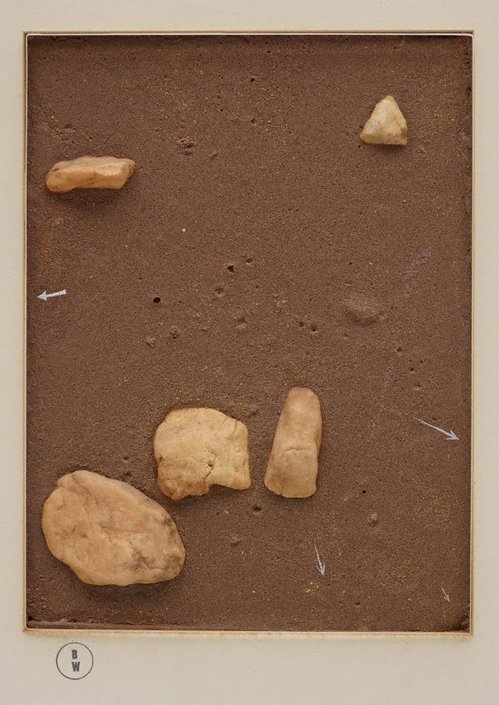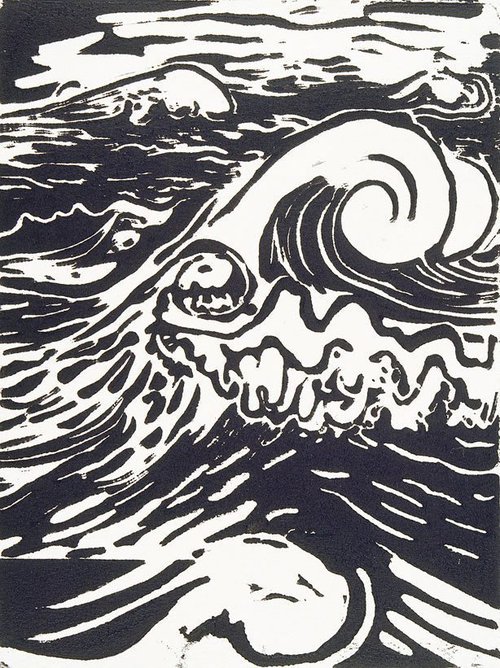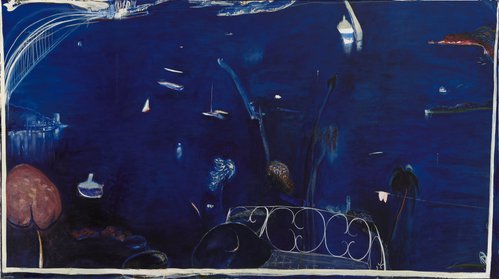Title
Alchemy
1972-1973
Artist
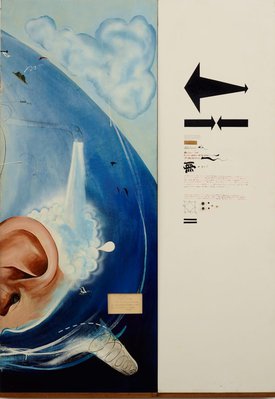
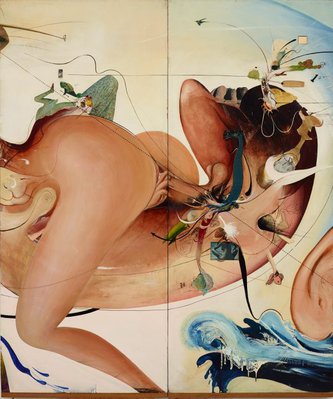
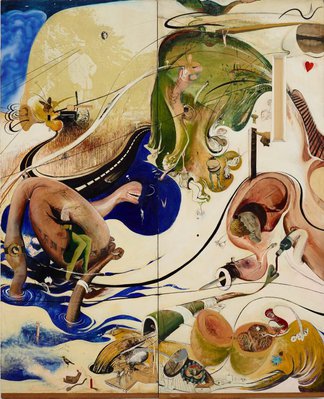
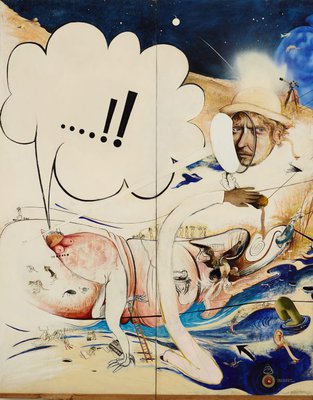


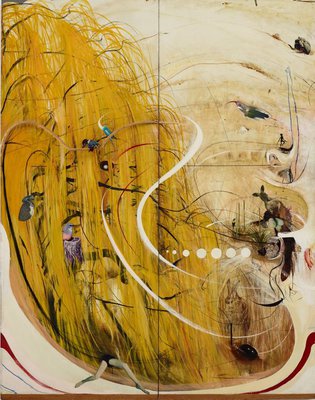
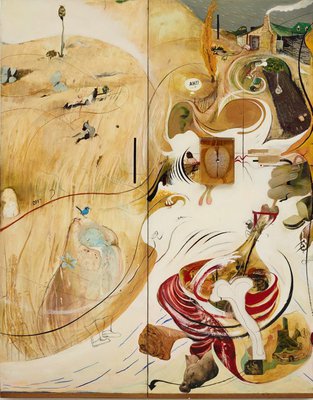


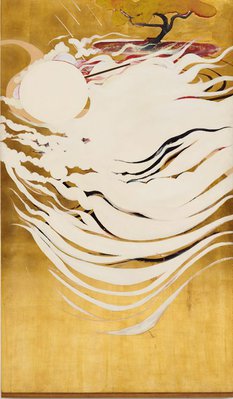
-
Details
- Date
- 1972-1973
- Media category
- Painting
- Materials used
- oil and mixed media on wood
- Dimensions
-
205.8 x 1617.0 x 3.3 cm overall
:
a - panel 1 (from right to left), 205.8 x 61 x 3.3 cm
b - panel 2 (from right to left), 205.8 x 81.3 x 3.3 cm
c - panel 3 (from right to left), 205.8 x 86.3 x 3.3 cm
d - panel 4 (from right to left), 205.8 x 86.3 x 3.3 cm
e - panel 5 (from right to left), 205.8 x 86.1 x 3.3 cm
f - panel 6 (from right to left), 205.8 x 81.3 x 3.3 cm
g - panel 7 (from right to left), 205.8 x 81.3 x 3.3 cm
h - panel 8 (from right to left), 205.8 x 81.2 x 3.3 cm
i - panel 9 (from right to left), 205.8 x 162.7 x 3.3 cm
j - panel 10 (from right to left), 205.8 x 81.3 x 3.3 cm
k - panel 11 (from right to left), 205.8 x 81.3 x 3.3 cm
l - panel 12 (from right to left), 205.8 x 81.2 x 3.3 cm
m - panel 13 (from right to left), 205.8 x 86.2 x 3.3 cm
n - panel 14 (from right to left), 205.8 x 75.9 x 3.3 cm
o - panel 15 (from right to left), 205.8 x 81.2 x 3.3 cm
p - panel 16 (from right to left), 205.8 x 81.3 x 3.3 cm
q - panel 17 (from right to left), 205.8 x 120.5 x 3.3 cm
r - panel 18 (from right to left), 205.8 x 120.6 x 3.3 cm
- Signature & date
Not signed. Not dated.
- Credit
- Purchased by the New South Wales State Government 1994, transferred to the Gallery 1998
- Location
- Not on display
- Accession number
- 348.1998.a-r
- Copyright
- © Wendy Whiteley/Copyright Agency
- Artist information
-
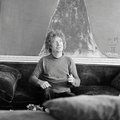 Brett Whiteley
Brett Whiteley
Works in the collection
- Share
-
-
About
Soon after his return to Australia from New York via Fiji in November 1969, Brett Whiteley began to exercise his imagination towards the conception of one of his greatest masterpieces. The multi-panelled 'Alchemy', which he completed in Sydney between early 1972 and January 1973, summarised a myriad accumulation of sources and influences – echoing to an extent The American dream realised in New York four years earlier but without its political outrage – manifesting itself finally as an autobiographical journey of gigantic, almost impossible ambition. Everything else Whiteley painted, before and after, can be measured against it.
Spread over eighteen panels, 'Alchemy' may be read from right to left as a birth-to-death vision; from elemental earthly existence through startling passages of flesh, fornication and the landscape of the artist's youth, coded along the way with collages of texts, writings, various attachments of objets trouve, to the climactic spectacle of a white tentacled sun set against a gold background on panels recycled from Whiteley's recent portrait of Yukio Mishima. This Japanese writer had committed seppuku two years earlier, having decided the gap between art and action could only be closed by ritual death. Removing the figurative presence of his original subject, Whiteley projected an idea of Mishima's final vision, as the sword cut into his flesh; a luminescent flash of transmutation into pure abstract spirit of white against gold; and a perfect image for the reductive climax of 'Alchemy'.
This left hand side was in fact the technical starting point of the painting, as Whiteley moved progressively left to right, away from the Mishima panels. But the composition can be read in either direction, even from the centre, where the word 'IT' holds the fulcrum between opposing extremes; between birth at one end and death at the other; between visceral humanity emerging from the cool realms of sea and sky, and the molten gold of spiritual enlightenment.
Completed in the gasworks studio not far from his house on Lavender Bay, 'Alchemy' also reflects something of Whiteley's personal life at that time. The stress of his ambition had gone hand-in-hand with tensions in his relationship with his wife Wendy during the painting of The American dream, leading to damaging bouts of alcohol abuse. Again he set out to test the capacity for art to influence society, to change it for the better. Entranced, even envious of the power of pop musicians, he dreamt of 'Alchemy' touching a mass audience, moving it with esoteric fragments of wisdom gleaned from cursory reading of philosophers, poets and novelists, and the lyrics of popular musicians. This could be a painting, he imagined, that might say it all. But he and Wendy were soon to drift into a life of more dangerous drug usage.
When it was first exhibited at the Bonython Gallery in January 1973, 'Alchemy' was accompanied by a catalogue assemblage of images and words from Whiteley's notebooks. Collectively this assemblage fails to make much sense, with quotes from Huysmans, Bacon, Dante, Dylan and many others, mingled with the artist's own aphorisms and anecdotes. However, there are occasional shafts of insight, in his own inimitable language, into the artist’s essential process: "'Alchemy' is the business of seeing what doesn't exist" he wrote; "The quest is the transmutation of Self"; "Most of this painting was first seen with the eyes closed in the pitch of night, awake"; or the often quoted "Art should astonish, transmute, transfix. Work at the tissue between truth and paranoia" [Barry Pearce, 'Brett Whiteley: art & life', London: Thames and Hudson, 1995, pg.34].
It seems Whiteley anticipated critics pointing out the connections of his surrealist imagery with the fifteenth-century painter Hieronymus Bosch, writing "I didn't look at Bosch once while painting any of this … This painting is about my inner paddock, which maybe means that all inner paddocks have similarness" [Statement amongst various papers in the artist's estate]. There is no doubt, nevertheless, that Bosch played an important part in both Alchemy and The American dream. On the way back from Morocco in June 1967 Whiteley went to Madrid to see the works of the Flemish master there, and was overwhelmed: "Incredible! ... What care and such menacing twitching really seen not invented images", he exclaimed on a postcard [Postcard to his mother Beryl Whiteley from Madrid, 20 June 1967, possession of recipient, Sydney].
He began reading about Bosch, and Paracelsus, the early sixteenth-century Swiss alchemist intrigued by the possibility of turning base metals into gold, viewed as a metaphor of the quest for divine transcendence. One idea associated with Paracelsus's theories was that beauty was merely a temporal skin, underneath which lay another quite opposing reality. The dichotomy between the seen and unseen, relevant to the phenomenon of Surrealism centuries later, was in accord with Whiteley's thinking. But above all, he drew from these theories an idea of painting as a vehicle by which life could become changed into art, the apparently ordinary into something extraordinary. Through all the rich detail and layers of 'Alchemy' this became its singular unifying theme.
Barry Pearce, Head Curator of Australian Art, Art Gallery of New South Wales, 2005
"Brett was not schizophrenic, but he was fascinated with the schizophrenic state of mind, in the sense of being split between good and evil – and what did power mean? What was the price to pay? Did it always lead to a dramatic event like Mishima's suicide? He destroyed his portrait of Mishima, joined the remaining panels, and 'Alchemy' just grew from there. There is paradise in hell in it, and all those little details are both humorous and quite frightening. Beautifully drawn, it is like a recipe. All the alchemists had various recipes for going about the transformation. The thing of base metal to gold is the most meaningless bit. More important is the search for the Holy Grail, the connection between heaven and hell, animal and spiritual. This was Brett's recipe … Quite a difficult picture to take in, in one hit. You do have to travel the journey with it."
Wendy Whiteley, 1995
-
Exhibition history
Shown in 24 exhibitions
Alchemy, Bonython Art Gallery [Sydney], Paddington, 1973–1973
Brett Whiteley Art & Life (1995-1996), Art Gallery of New South Wales, Sydney, 16 Sep 1995–19 Nov 1995
Brett Whiteley Art & Life (1995-1996), Museum and Art Galleries of the Northern Territory, Darwin, 13 Dec 1995–28 Jan 1996
Brett Whiteley Art & Life (1995-1996), Art Gallery of Western Australia, Perth, 22 Feb 1996–08 Apr 1996
Brett Whiteley Art & Life (1995-1996), Art Gallery of South Australia, Adelaide, 09 May 1996–16 Jun 1996
Brett Whiteley Art & Life (1995-1996), Art Gallery of New South Wales, Sydney, 02 Jul 1996–26 Aug 1996
Brett Whiteley Art & Life (1995-1996), Tasmanian Museum and Art Gallery, Hobart, 18 Sep 1996–17 Nov 1996
Big Blue - the painted harbour (1997), Art Gallery of New South Wales, Sydney, 21 Jun 1997–29 Mar 1998
Instantly: Whiteley with words (2000), The Brett Whiteley Studio, Surry Hills, 08 Apr 2000–16 Jul 2000
Australian icons: twenty artists from the collection, Art Gallery of New South Wales, Sydney, 04 Aug 2000–03 Dec 2000
Animals and Birds, The Brett Whiteley Studio, Surry Hills, 15 Jun 2002–06 Oct 2002
Brett Whiteley: Key works from the Studio, The Brett Whiteley Studio, Surry Hills, 24 Jul 2004–03 Oct 2004
The Poetic Eye, The Brett Whiteley Studio, Surry Hills, 13 Dec 2007–19 Jul 2008
Whiteley and the third dimension, The Brett Whiteley Studio, Surry Hills, 19 Jul 2008–15 Mar 2009
Endlessnessism (2010-2011), The Brett Whiteley Studio, Surry Hills, 28 Aug 2010–03 Jul 2011
Blue (2011), The Brett Whiteley Studio, Surry Hills, 09 Jul 2011–08 Jul 2012
The London years 1960-67 (2012), The Brett Whiteley Studio, Surry Hills, 14 Jul 2012–13 Feb 2013
The nude: erotic, sensual and sacred, The Brett Whiteley Studio, Surry Hills, 12 Apr 2013–01 Sep 2013
Alchemy-Pop, The Brett Whiteley Studio, Surry Hills, 31 Oct 2014–31 May 2015
Brett Whiteley: sculptures and ceramics, The Brett Whiteley Studio, Surry Hills, 05 Jun 2015–06 Dec 2015
Brett Whiteley: Other Places (somewhere else), The Brett Whiteley Studio, Surry Hills, 11 Dec 2015–08 May 2016
Tributes, The Brett Whiteley Studio, Surry Hills, 13 May 2016–13 Nov 2016
Brett Whiteley: West of the Divide, The Brett Whiteley Studio, Surry Hills, 19 May 2017–19 Nov 2017
Beach, The Brett Whiteley Studio, Surry Hills, 24 Nov 2017–25 Mar 2018
Pathways to figuration, The Brett Whiteley Studio, Surry Hills, 31 Mar 2018–07 Oct 2018
Brett Whiteley: Another way of looking... Vincent., The Brett Whiteley Studio, Surry Hills, 18 May 2018–13 Oct 2019
Brett Whiteley: Wildlife and other emergencies, The Brett Whiteley Studio, Surry Hills, 12 Oct 2018–May 2019
Brett Whiteley: Australia, The Brett Whiteley Studio, Surry Hills, 03 Dec 2021–17 Apr 2022
Brett Whiteley: Eternity is Now, The Brett Whiteley Studio, Surry Hills, 03 Dec 2022–13 Aug 2023
-
Bibliography
Referenced in 27 publications
-
Bruce Adams, Sunday telegraph, 'Whiteley rampant', Sydney, 14 Jan 1973.
-
Nancy Borlase, Bulletin, 'Whiteley's promised land', Sydney, 13 Jan 1973.
-
Margaret Clarke (Director), Red, black and Whiteley, North Ryde, 2000, 00:02.00 for 2 minutes (colour, details). Details of different sections of the work. Camera pans across work as Wendy Whiteley discusses. The painting reflects the transformation from one state to another. She refers to it as a diary recording these shifts - searching and looking to change oneself and other people.
-
Jonathan Cooper (Editor), Exhibitions events - Art Gallery of New South Wales, Sydney, May 1999-Jul 1999, 16 (colour illus.).
-
Sarah Engledow., White, Whiteley: the portrait of Patrick White by Brett Whiteley, ‘White Whiteley’, Canberra, May 2010. not paginated; viewed 01.02.2013, http://www.portrait.gov.au/site/exhibition_subsite_whitewhiteley.php
-
David Evans and Elizabeth Fortescue, Courier Mail, 'A victim of habits: The life and times of Australian artists Brett Whiteley', pg. 9, Queensland, 17 Jun 1992, (illus., detail).
-
Elizabeth Fortesque, Daily telegraph, 'Master strokes', pg. 124, Sydney, 22 Jul 2000, 124. Review of 'Australian Icons' exhibition.
-
Alec George, Look, 'Whiteley's 'inner paddock', pg. 26, Sydney, Jun 2014, 26 (colour illus., detail).
-
Janet Hawley, Good Weekend Magazine, 'Brett Whiteley: the art of the warrior', pg. 16-26, Sydney, 17 Feb 1990, 24, 26.
-
Janet Hawley, Artists in conversation, 'Brett Whiteley', pg. 92-107, Richmond, 2012, 92 (illus., detail), 100. Whiteley is photographed laying down in front of the central panel of the work.
-
Janet Hawley, Good Weekend Magazine, 'Still life', pg. 18-24, Sydney, 02 Jul 1994, 20, 22.
-
Janet Hawley, Good Weekend Magazine, 'The Whiteley women', pg. 10-20, Sydney, 18 Jul 1992, 16.
-
Bruce James, Whiteley with words, 'Whiteley with words', pg. 2-4, Sydney, 2000, 3 (colour illus., detail, panel 18), 8.
-
Elwyn Lynn, Quadrant, 'Brett Whiteley: the grand works', pg. 37-44, Sydney, Oct 1976, 39-42 (illus.), 44. includes fold- out page article 'The hidden Brett Whiteley'
-
Sandra McGrath, Quadrant, 'Brett Whiteley's Alchemy', pg. 32-35, Sydney, Sep 1978, 32 (illus., detail), 33 (illus., detail), 34 (illus., detail), 35.
-
Sandra McGrath, Brett Whiteley, 'Alchemy', pg. 136-149, Kensington, 1979, 136 (colour illus.), 137-138, 139 (colour illus.), 140-142, 143-149 (colour illus.). Panels are numbered in reverse order. Illus. on pg. 136 is a detail of panel no. 1. Illus. on pg. 139 is a detail of panel no. 6.
-
Humphrey McQueen, Art Monthly Australia, 'Positions vacant', pg. 21-23, Canberra, Sep 2000, 22-23. Review of 'Australian icons' exhibition.
-
Barry Pearce, Brett Whiteley Art & Life, 'Persona and the Painter', pg. 15-41, London, 1995, 34-35, 38, 164, 182-187 (colour illus.), 234. plate no. 125a-f
-
Barry Pearce., Education collection notes: Brett Whiteley, Alchemy, 'Brett Whiteley: Alchemy', Sydney, 2006, (colour illus.). Not paginated.
-
Barry Pearce, Australian painters of the twentieth century, 'Brett Whiteley', pg. 232-243, Sydney, 2000, 238-239 (colour illus.), 239 (colour illus, detail).
-
Barry Pearce, Australian art: in the Art Gallery of New South Wales, 'Introduction', pg. 10-16, Sydney, 2000, 14-15 (colour illus.), 16, 302.
-
Katrina Strickland, The Weekend Australian Financial Review, 'Whiteley's work crosses borders, times and lives', pg. 36-37, Sydney, 06 Nov 2010-07 Nov 2010, 37.
-
Kathie Sutherland, Brett Whiteley: A sensual lilne 1957-67, Victoria, 2010, 199.
-
Jill Sykes (Editor), Look, 'Whiteley and the men he admired', pg. 10, Sydney, Feb 2015, 10.
-
The Brett Whiteley Studio (Editor), Big blue: the painted harbour (list of works), Sydney, 1997.
-
Daniel Thomas, The Sydney Morning Herald, 'A literal autobiography in eighteen panels', Sydney, 11 Jan 1973.
-
Laurie Thomas., The Australian, 'Alchemy with a poetic impact', Sydney, 17 Aug 1974.
-


